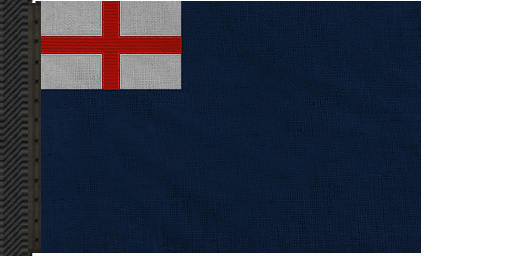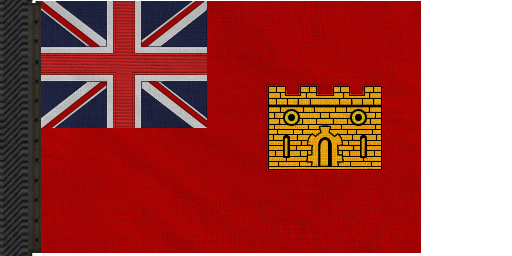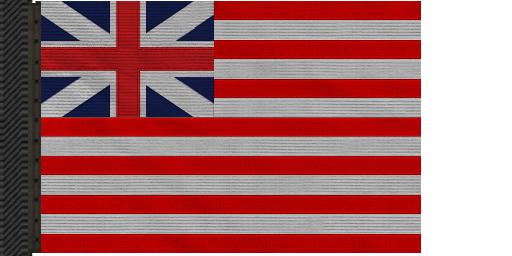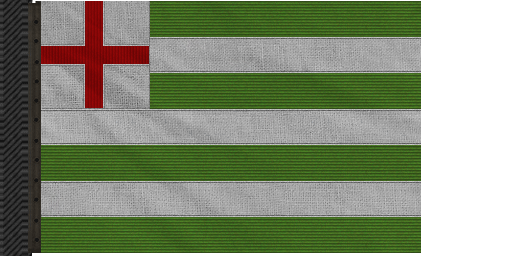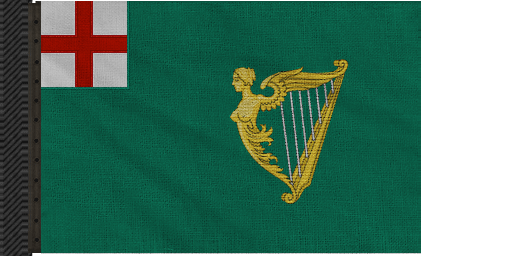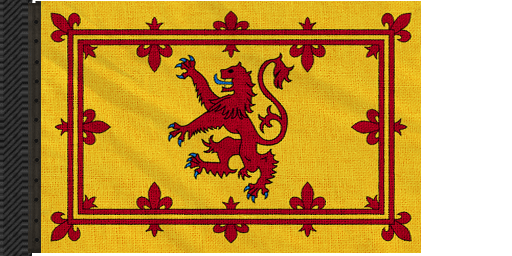FLAGS OF GREAT BRITAIN
Great Britain national Flag
The flag of the White Squadron commissioned in the beginning of the nineteenth century. During the reign of Queen Elizabeth I of England the Royal Navy was divided into three squadrons: the red, the white and the blue to improve command and control of the Royal Navy. The variation of the flag was commissioned after the union of Great Britain and Ireland in 1801 and features the new Union Jack with the Saint Patrick's Cross in the first quarter and the red cross on a white background.
Blue Ensign 1625 Flag
The flag of the Blue Squadron commissioned circa 1620 - 1630. During the reign of Queen Elizabeth I of England the Royal Navy was divided into three squadrons: the red, the white and the blue to improve command and control of the Royal Navy. The flag represents Saint George's cross - the flag of England - in the first quarter on a dark blue background.
Blue Ensign 1707 Flag
The flag of the Blue Squadron commissioned in 1707 after the Acts of Union and creation of the Kingdom of Great Britain. During the reign of Queen Elizabeth I of England the Royal Navy was divided into three squadrons: the red, the white and the blue to improve command and control of the Royal Navy. The flag represents the Union Jack - flag of the Kingdom of Great Britain - in the first quarter on a dark blue background.
Blue Ensign Blue
The flag of the Blue Squadron commissioned in 1707 after the Acts of Union and creation of the Kingdom of Great Britain. During the reign of Queen Elizabeth I of England the Royal Navy was divided into three squadrons: the red, the white and the blue to improve command and control of the Royal Navy. The flag represents the Union Jack - flag of the Kingdom of Great Britain - in the first quarter on a light blue background.
Chase Flag
The Customs chase flag was commissioned by the end of the eighteenth century. The flag was used by customs ships and protected customs personnel against prosecution for any damages they caused under this flag. It consists of the Union Jack - flag of the Kingdom of Great Britain - in the first quarter and a castle-like Custom House in the fourth quarter on a dark blue background.
Customs Flag
The Customs flag was initially introduced by a Royal Proclamation at the end of the seventeenth century. It was used by customs ships on daily duties. This variation of the flag was commissioned after the union of Great Britain and Ireland in 1801 and features the new Union Jack with the Saint Patrick's Cross in the first quarter and a castle-like Custom House in between the second and the fourth quarter on a dark red background.
East India Company 1668 Flag
The flag of the East India Company - a chartered company created in the beginning of the seventeenth century to trade with the East Indies. It was used on trade and war ships of the Company. The variation of the flag was commissioned after the creation of the Kingdom of Great Britain and features the Union Jack - flag of the Kingdom of Great Britain - in the first quarter and alternating red and white stripes, seven red and six white ones.
East India Company Flag
The flag of the East India Company - a chartered company created in the beginning of the seventeenth century to trade with the East Indies. It was used on trade and war ships of the Company. This variation of the flag was commissioned after the union of Great Britain and Ireland in 1801 and features the new Union Jack with the Saint Patrick's Cross in the first quarter and alternating red and white stripes, seven red and six white ones.
Royal Naval Ensign - Siege of La Rochelle
The royal naval ensign was used at the Siege of La Rochelle in 1627-1628 against French forces. It consists of the square-shaped Saint George's cross - the flag of England - in the first quarter and alternating dark blue and red stripes, five dark blue and four red ones.
Tudor Naval Ensign
The Tudor navy ensign that was widely used during the reign of the Tudor dynasty from 1485 to 1603. The flag consists of the square-shaped Saint George's cross - the flag of England - in the first quarter and alternating white, blue and red stripes, three of each type.
Tudor Naval Ensign - Capture of Cadiz Green
The Tudor navy ensign was used during the reign of the Tudor dynasty from 1485 to 1603. This variation of the Navy Ensign was used on one of the squadrons that were sent on the task to capture Cadiz in 1596. The flag consists of the square-shaped Saint George's cross - the flag of England - in the first quarter and alternating green and white stripes, four green and three white ones.
Tudor Naval Ensign - Capture of Cadiz Blue
The Tudor navy ensign was used during the reign of the Tudor dynasty from 1485 to 1603. This variation of the Navy Ensign was used on one of the squadrons that were sent on the task to capture Cadiz in 1596. The flag consists of the square-shaped Saint George's cross - the flag of England - in the first quarter and alternating green-blue and white stripes, seven greenish-blue and six white ones.
Saint George’s Cross
The Tudor navy ensign in the form of the Saint George's cross. The flag was used during the reign of the Tudor dynasty from 1485 to 1603. Saint George is the patron saint of England, and his cross was adopted by English kings in the Middle Ages. It consists of the red cross on a white background.
Royal Standard - House Stuart
The royal standard of Queen Anne, House of Stuart. The standard indicates the presence of the monarch aboard and was commissioned after the creation of the Kingdom of Great Britain. The first and fourth quarters represent England and Scotland, the second quarter represents a claim to the French crown and the third quarter represents Ireland.
Ireland Flag
The Green ensign was used by Irish vessels circa 1701, before the creation of the Kingdom of Great Britain. The flag consists of the square-shaped Saint George's cross - the flag of England - in the first quarter and a golden harp on a green background.
Old East India Company
The flag of the East India Company - a chartered company created in the beginning of the seventeenth century to trade with the East Indies. It was used on trade and war ships of the Company. The variation of the flag was commissioned in the second half of the seventeenth century and features the Saint George's cross - the flag of England - in the first quarter and alternating red and white stripes, five red and four white ones.
Red Ensign 1625 Flag
The flag of the Red Squadron commissioned circa 1620 - 1630. During the reign of Queen Elizabeth I of England the Royal Navy was divided into three squadrons: the red, the white and the blue to improve command and control of the Royal Navy. The flag represents Saint George's cross - the flag of England - in the first quarter on a red background.
Red Ensign 1707 Flag
The flag of the Red Squadron commissioned in 1707 after the Acts of Union and creation of the Kingdom of Great Britain. During the reign of Queen Elizabeth I of England the Royal Navy was divided into three squadrons: the red, the white and the blue to improve command and control of the Royal Navy. The flag represents the Union Jack - flag of the Kingdom of Great Britain - in the first quarter on a red background.
Red Ensign Wide
The flag of the Red Squadron commissioned circa 1620 - 1630 with the large Saint George cross. During the reign of Queen Elizabeth I of England the Royal Navy was divided into three squadrons: the red, the white and the blue to improve command and control of the Royal Navy. The flag represents Saint George's cross - the flag of England - in the first quarter on a red background.
The Royal Standard of Scotland
The standard was used to indicate the presence of the Scottish monarch aboard before the Union with England. It consists of a red lion rampant within a red double border on a yellow background.
Scotland Red Ensign
The Scottish red ensign was used by the Royal Scots Navy before the Union with England, after that it was merged into the British Royal Navy. The ensign consists of Saint Andrew cross in the first quarter on a red background.
White Ensign 1625 Flag
The flag of the White Squadron commissioned circa 1620 - 1630. During the reign of Queen Elizabeth I of England the Royal Navy was divided into three squadrons: the red, the white and the blue to improve command and control of the Royal Navy. The flag represents Saint George's cross - the flag of England - in the first quarter on a white background.
White Ensign 1707 Flag
The flag of the White Squadron commissioned in 1707 after the Acts of Union and creation of the Kingdom of Great Britain. During the reign of Queen Elizabeth I of England the Royal Navy was divided into three squadrons: the red, the white and the blue to improve command and control of the Royal Navy. The flag represents the Union Jack - flag of the Kingdom of Great Britain - in the first quarter and the red cross on a white background.
White Ensign Wide
The flag of the White Squadron with the wide red cross was commissioned in 1707 after the Acts of Union and creation of the Kingdom of Great Britain. During the reign of Queen Elizabeth I of England the Royal Navy was divided into three squadrons: the red, the white and the blue to improve command and control of the Royal Navy. The flag represents the Union Jack - flag of the Kingdom of Great Britain - in the first quarter and the red cross on a white background.

